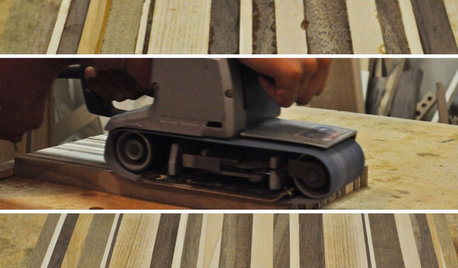High phosphorus level
I have posted this on the soil forum but would like some advise from our Oklahoma gardners
My soil test from the extension service came back really high iin phosphorus.
The test results
ph 7.3
n 328
p 1173
k 2134
Very high nutirent levels but excessive phosphorus. No commercial fertlizer has been added just compost mixture of vegs, horse manure and clay.
Has anyone lowered their phosphorus level?
Jan
Comments (21)
slowpoke_gardener
11 years agolast modified: 9 years agoMy P and K dropped when I cut back on the organic matter I was tilling into the soil. This Past year I started adding more organic matter, but my soil test is not due back for another week of so. My highest (2010 test) K was 958, highest P was 515. In 2011 the high was K 242 and P 184. You can see it dropped and all I did was to stop placing the clay that I would get from planting a tree or digging a post hole and placing it into the garden.
I have very shallow soil and I feel that if I keep the sub-soil out of the root zone my numbers will improve. My plan is to test as needed, continue with the organic matter as long as my soil produces well. ( It has produced well even with high P, K, and Zn.)
My PH has tested from 5.8 to 6.8, I would like to keep it between 6 and 7.
In short, my P. K and Zn dropped about 50% in one year by reducing the oak leave and placing my sub soil into low areas in my lawn, but I may be singing the blues again when my soil test results come in. I did not test last year.
Larry
okak
Original Author11 years agolast modified: 9 years agoThanks Larry,
Will reduce the organic matter and see what happens too.
I am worried about planting the beds now with such high levels. Is there anything I can do now to help? Also did you have severe results on your vegs with high levels?
Please post your soil results when you get them
JanRelated Professionals
Rossville Landscape Architects & Landscape Designers · Gainesville Landscape Contractors · Wilmington Landscape Contractors · East Hanover Landscape Contractors · Framingham Landscape Contractors · Lyndhurst Landscape Contractors · Mastic Beach Landscape Contractors · Nashua Landscape Contractors · Waldorf Landscape Contractors · Woodland Landscape Contractors · Baltimore Decks, Patios & Outdoor Enclosures · Del Aire Decks, Patios & Outdoor Enclosures · Framingham Decks, Patios & Outdoor Enclosures · Manchester Decks, Patios & Outdoor Enclosures · Northglenn Decks, Patios & Outdoor Enclosuresslowpoke_gardener
11 years agolast modified: 9 years agoJan, another thing I did was plant corn heavily. I had heard it likes P. & K.. The first corn stalks were fed to the cows, the second crop stalks were tilled in. I dont know what made the difference, but I like my mineral count to be more near a normal range.
My vegges looked good all the time, I had no idea that I had a high mineral count. I would think the high mineral count would be more toxic to the plants than to humans. I live in an old coal mining area, the county agent said almost everyone around here has a lot of mineral in there soil. I am really more concerned about what is in the water because of the coal mines and the gas wells. There is a high cancer rate but I think the cancer rate is high everywhere.
I dont think the vegges take in all the mineral, I rather believe that the proper balance makes it easier for the proper reactions to take place in the soil for healthy microbes which helps make healthy plants.
I will post the results of my soil test. One of the reasons for wanting the test, is that I had an outbreak of Rootknot nematodes, and adding extra organic matter was one of the things I did to try to combat them.
Larry
Okiedawn OK Zone 7
11 years agolast modified: 9 years agoJan,
There really isn't a way to lower your phosphorus level. Just be careful that you do not inadvertently add more phosphorus by using animal manures. I'd just make and add compost (but without manures being a part of it) or only add a organic source of nitrogen when the plants indicate they need more N (if they ever do indicate they need more). You really cannot remove minerals like phosphorus once they are in the soil. You just have to wait for time and for rainfall to help leach the excess phosphorus out of the soil and for plants to use up the phosphorus. I've always had high phosphorus soil, but you'd never know it by looking at my plants because they grow and produce just fine and I don't spend any time at all worrying about the high phosphorus or trying to fix it (which I don't even think is possible for a home gardener to do). As long as my plants are happy and healthy, I don't care what the soil tests show. Soil tests can tell you what your levels are, but do not necessarily give you any idea of how readily the plants will or will not take up those nutrients. It is possible to have high phosphorus levels in your soil and still have plants show a phosphorus deficiency if the phosphorus is not in a form that is available to the plants for uptake.
A soil test doesn't tell you ihow much of the phosphorus is in a form that can be and will be taken up readily by the plants, so you won't know until you grow something in that soil if the phosphorus is even an issue in and of itself. I'm betting it won't be.
You can try Larry's corn-growing trick to help deplete the phosphorus more quickly, or ca do the same with a cover crop or living mulch of buckwheat.
You'll just have to watch your plants this year and see if you see any sign of a nutritional imbalance. It might be that the high phosphorus might interfere with the uptake of various micronutrients, but then again, that might not happen either. I wouldn't worry about it in advance. I'd just plant my garden and see what happens. Plants are really good at taking up the nutrients they need with no help from us whatsoever and I'm going to guess that after they take up what they need, they don't continue sucking up excessive amounts of phosphorus from the soil.
All I've tried to do since moving here is to add organic matter to the soil over the years and to work to bring down the pH naturally. You can drive yourself crazy obsessing over numbers. I ignore the numbers and watch the plants. If they are happy, are growing well, look good and produce well, then the numbers on the soil test are irrelevant to me.
Dawn
okak
Original Author11 years agolast modified: 9 years agoThank you both so much. I have been fretting the last few days about the test and what I was going to do. I will try Larrys corn planting in half of the area and just plant my vegs when the temp is right in the rest of the beds and watch them very closely. I want to cover the beds after I plant but. I can not use oak leaves and do not want to use bermuda grass clippings, do you have any suggestions for mulch? My garden budget will still allow us to purchase mulch if need be.
Janokak
Original Author11 years agolast modified: 9 years agoDawn,
Wow. I have read your post four times and will print it out for further use.
You have provided me with so much needed information. I feel so much better as I was stressed out about the high numbers. New sillly gardner huh?
I have oak leaves to use and I will get some newspaper and cardboard
I also will look into alfafa hay and can get pine bark at the nurseryAs a x volunteer emt I can relate to your fire work. Our volunteer fire department required all volunteers to be able to drive all the equipment and do surveilance etc. I did not mind driving the ambulance or the tanker but the ladder truck was a real challenge. The work you and your hubby and son do is admirable.
Janokak
Original Author11 years agolast modified: 9 years agoDawn,
Wow. I have read your post four times and will print it out for further use.
You have provided me with so much needed information. I feel so much better as I was stressed out about the high numbers. New sillly gardner huh?
I have oak leaves to use and I will get some newspaper and cardboard
I also will look into alfafa hay and can get pine bark at the nurseryAs a x volunteer emt I can relate to your fire work. Our volunteer fire department required all volunteers to be able to drive all the equipment and do surveilance etc. I did not mind driving the ambulance or the tanker but the ladder truck was a real challenge. The work you and your hubby and son do is admirable.
JanOkiedawn OK Zone 7
11 years agolast modified: 9 years agoHey Jan,
I'm glad the info is useful.
Generally I don't fight fires unless I see a firefighter in a pinch who needs someone to pull hose for him or something. I serve a different role.
I do a task known as fire rehab. The simple description is that I take water, Gatorade (and iced tea sometimes in summer or hot coffee in winter) to fire call locations for the firefighters, as well as snacks and meals. Usually this is for prolonged wildfires, but also for days when there is one 'little' fire after another, or for long, complicated motor vehicle accident scenes where you have a road or highway shut down for hours and firefighters must remain on the scene a very long time. Sometimes it involves flood scenes, or drowning recovery scenes. Wherever our VFD goes, we follow to ensure they are well-hydrated and well-fed. It sounds so simple, but if you're dealing with a multiple-day wildfire involving as many as 14 local departments (and sometimes departments from other counties as well as OFS crews and BIA crews), it can get really complicated to obtain and prepare enough food for everyone as quickly as you need it. I like the challenge, though, and the firefighters I work with feel like they are very well--fed and spoiled rotten. That's the least I can do for the men and women in our county who work so hard as volunteers to keep the rest of us safe and to protect people, animals and property from harm.
We also work with the Incident Commander to identify firefighters who are developing a health issue at a scene and to get them into the shade, into an air-conditioned vehicle, etc., to cool down while we wait for the medics to arrive. Our VFD has four registered members who mostly do only rehab, though one of them also often drives a tanker truck to a scene when more tankers are needed. Another firefighter switches easily from the firefighter role to the fire rehab role as needed.
My only real issue is that winter/spring fire season often collides with spring planting season and I have to put the fires ahead of my gardening of course. There are days that is very frustrating. This has been a week in which firefighting has kept my out of the garden most of the time, but that's life.
It seems like the quickest way to make our fire pagers go off is merely to go out to the garden, but I'm going to go out there after lunch anyway.
Dawn
chickencoupe
11 years agolast modified: 9 years agoDawn;
thank you thank you thank you thank you thank you
Because of availability the only hay I've been able to get for my rabbits is Alfalfa. Combined with the rabbit poop and left over hay, it goes right into the garden. I was wondering if the alfalfa was not too much nitrogen. According to this post, I need watch the phosphorous content. I suppose I may need to begin piling the manure somewhere else and allowing it to rot a good long time before adding it to the gardening in the fall to be overwintered. I've left a request on the mulch forum.
I'm excited to know I can use alfalfa hay as mulch and that's it's of great benefit.
Okiedawn OK Zone 7
11 years agolast modified: 9 years agoBon, Alfalfa is the best stuff. I love alfalfa. I think it would be impossible to get too much nitrogen from the alfalfa. It will do amazing things for your soil. Just watch and you'll see.
I do not worry about phosphorus. Even when it tests high, most of it must be in a form not readily available for uptake (the soil tests don't tell you this), so it can just sit there and pout because your plants cannot take it up.
Another great way to use alfalfa? It makes a great moth trap. Put some water in a 5-gallon bucket (I use the oh-so-unattractive cat litter buckets that otherwise would go in the trash) and put alfalfa in it. Set it someplace that has light at night. I place the bucket right beside the electric pole that has our security light on it. The moths flock to the light, and then there is something about the 'alfalfa tea' they find appealing. I find oodles of moths floating in the alfalfa tea every morning. Usually they are the little moths whose caterpillars are destructive to our gardens. I scoop out the dead moths every morning, and the next morning there are more of them. It is the easiest way I have found, too, to monitor the moths and know when their population is getting huge (like the cutworm moths last year that were present in huge numbers as early as January).
I think sometimes that manure takes an unfair share of the blame for high phosphorus levels in soil. Buy a bag of Black Kow manure (I suggest this brand because it is 100% composted manure whereas the law allows 90% filler to be used, so some other brands are only 10% manure). Plant something in 100% Black Kow manure (or any other brand that has no fillers in it--the fillers often are yucky black clay) and watch it grow and produce like crazy. If the manure was too high in phosphorus, you'd think you'd see some sort of sign in the plant growth, and I never have.
Dawn
Here is a link that might be useful: Growing Tomato Plants in Bags of Black Kow
chickencoupe
11 years agolast modified: 9 years agoCool moth info! Look out moths!! I'm doing that first thing in the morning under all the lights.
I got excellent responses from the mulch forum. Someone versed in bunny "stock" advised me they will be eating the parts highest in phosphorous and I could "throw at will". What'd Will ever do? lol Many suggested I be certain to compost the bunny poop well into good hot composts over the summer reminding me not to throw it in there fresh. Gulp .. forgot about that.
The rabbit cages are indoors. The spent alfalfa on the floors without too much manure go for mulching. The rest will be piled and allowed to compost or rot. In the fall I will continue layering it right on top of the soil.
I use your no-till method since my soil is great but just too much clay. (But not red like yours). This layering method makes it soft and fluffy, dark and moist - like forest bottom soil. Really looking forward to this year's results.
Someone suggested I throw radishes and bunny greens in the dirt and see how they come out to determine any nutritional needs or deficiencies. Bunnies don't care if the greens are bitter or deformed. No time wasted. Good point!
bon
Okiedawn OK Zone 7
11 years agolast modified: 9 years agoWill gets mistreated a lot...throw at will, shoot at will, etc.
Yesterday I had clay and sand, today I have mini-lakes and mud. I guess that means I won't be able to work in the garden for a while, but it is good to have so much rain. Today's rainfall is our biggest rainfall since last July, and it isn't that big--there was 1.5" in the gauge last time I checked, but we'll take it. Most of that fell in about a 30 or 40 minute time frame. We'd had that much rain or more from persistent showers that last for 2 or 3 days in recent months, but this is the first big one-day rainfall for us in a while. I remember, pre-extreme-drought-years, when I thought a big rainfall was 5" or 9" or 12" in one day. Now, when 1.5" falls in one afternoon, it is a big rainfall.
I think a lot of the excess phosphorus in soil just gets leached into ground water and water sources like ponds, streams, etc.
My pea plants got pounded by pea-sized hail this afternoon, which I thought was amusing. I wouldn't have been amused if the hail had been quarter-sized or larger, maybe not even if it was nickle sized. Some marble sized hail fell into the lawn, but not the adjacent garden. That was odd.
chickencoupe
11 years agolast modified: 9 years agoI understand the "big rain" theory. Amazing how quickly the perspectives can change.
I'm glad that hail didn't get any bigger! .95 within 12 hours. I bet you need a pontoon right now!
lol
slowpoke_gardener
11 years agolast modified: 9 years agoIt is really strange how different gardens are. My north garden has been wet all winter long. My south garden was getting a little drier than I like. I built the south garden in the same way I built the south garden. They are about 120 feet apart and the south garden is about 1.5 feet higher, but slightly more sandy soil. They are both very wet now because it has been raining all night. The plants I have under the lights may have go in the south garden and save the north garden for summer crops.
The last local info I remember seeing said we were still 4.68" short to break the drought. I really would like to save that 4.68" for a little later in the year.
Larry
Okiedawn OK Zone 7
11 years agolast modified: 9 years agoBon, I had been watching the hail core in radar on storms in Texas as it moved our way and I was fairly certain we were going to get hit. I just was hoping the storms were expending enough energy hailing in Texas that the hail would be "small potatoes" (Ha, excuse the gardening pun) when it made it here, and it was. Parts of Texas took a severe beating from wind and hail, and that is unfortunate.
I was just relieved the hail was pea-sized hail and not anything bigger. If it had been radish-sized to beefsteak-tomato-sized hail, I would have been a really unhappy gardener. I looked at the garden this morning and there's not one bit of damage from the hail.
Larry, I agree with you on the odd differences you can find in gardens that are in close proximity to one another. Our land is all over the place in terms of its composition. Unfortunately most of the upland area where we live and garden is red clay, but there are spots with a silty-sand and a few areas with a clayey-sandy blend.
My best gardening spots still are the clay ones once the clay has been amended with large amounts of organic matter. Some of the sandy-silty areas drain so quickly that I don't know if we ever could amend them well enough to be great garden soil. They're really low in nutrients while our clayier areas are high in most nutrients.
As much rain as you've had, I'm surprised y'all aren't out of drought already. The last time that I looked at the PDI map that tells us how much rain we need to get out of drought, I think most of us still were in the 6-9" area.
I'll go find that map and link it. It has been a few weeks since I looked at it, and a lot of us ought to be able to see some improvement on the latest edition of that map.
Dawn
Here is a link that might be useful: {{gwi:367116}}
chickencoupe
11 years agolast modified: 9 years agoWow!? Only 3 more inches needed in our area? Seems worse than that, me thinks. OH well..
slowpoke_gardener
11 years agolast modified: 9 years agoJan,
You ask that I post my soil test when it came. I took pictures of the test sheets, I hope you can blow them up enough to read them. As you can see my numbers are still high and probably always will be.
My next step is to see if I can lower the Zn. I doubt that there will be an affordable way for me to do that.
You can see that my PH has also gone up. The last test I believe was 5.9 and 6.0. I added lime, shooting for 6.5, as you can see I shot high and ended up 6.9 and 7.0. I will just leave that alone and it should start working its way down.
Over all I am happy with the test, but will continue to try to tweak it.
I think adding the extra organic matter has raised my numbers but I dont intend to quit. My next step may be going to a no till garden and just add organic matter as mulch.
Larry
Okiedawn OK Zone 7
11 years agolast modified: 9 years agoBon,
I know it seems like it is too little, but keep in mind that this is the Long Term Palmer Drought Index and it relates more to long-term conditions over the broad-scale. That's how much rain you'd need today. Let's say you need 3" per this map and your average rainfall for March is 4". Not counting any rain that already has fallen in March, you'd need 7" by the end of the month, and that's not real likely to happen in the next couple of weeks, right? I have a feeling that if you had 7" of rain between now and then end of March, you would indeed feel your drought was over, at least for a little while.
One thing about very severe drought is that we never really get all that moisture back again. Let's say an area had rainfall for three years in a row that was 10" below average, leaving them with a 30" deficit. It is highly unlikely that enough rain would fall in the next decade to wipe out that deficit. That's why some of us here in southern OK where we have had repeated droughts in recent years (2003, 2005, 2006, late 2007 through early 2009, 2011, 2012) have seen springs stop running and ponds and creeks dry up permanently....too many years of deficit rainfall and you just reach a point where the springs don't come back, so the formerly spring-fed ponds and creeks become only seasonal ponds and creeks that merely catch rain runoff where there is lots of rain, but dry up otherwise and stay dry. I remember when the drought of 2008 hit, there were stories on the news featuring local ranchers whose land, particularly their forage grasses, empty ponds and empty creeks, hadn't even fully recovered from the 2005-06 drought. With ponds still dry from 2005-06, they were in even worse shape in 2008 because there was no stored water to fall back on.
For what it is worth, I always feel like we are in drought even when the Drought Monitor is saying we aren't, and then by the time the Drought Monitor shows us merely as "Abnormally Dry", I feel like we already are in horrific drought. All these maps and forecasts cover broad and general areas, but smaller areas within those larger ones may not have identical issues. You could, for example, be much drier or much wetter than the data indicates for your area. Take all the maps, charts, diagrams, and forecasts with a grain of salt....they attempt to quantify what is being observed over a large area, but they are not the same as a gardener with boots on the ground observing their own conditions.
Larry, Really, I wouldn't worry about zinc. High zinc doesn't necessarily mean that the plants would have zinc toxicity because they won't necessarily absorb the excess zind. It could be that your soil and/or your water are naturally high in zinc and if that's the case, there's not much you can do about it. I've never seen zinc toxicity in any plants grown in the ground in a home garden. You can find it sometimes in container plants, but usually that only happens if they were planted in an odd soil mix or deliberately given too much zinc somehow. You might see it on farmland that has been heavily fertilized and manipulated over a long period.
One thing you often see with soil that has good levels of organic matter is that it seems to act as a buffer with the macronutrients and micronutrients--seeming to prevent the plants from taking up excess amounts of macro- and micro-nutrients even when they do exist in the soil. I think that is part of the mystery of organic matter....the way it influences processes in ways we don't even understand.
Your pH is really great, in general, for veggie growing. I always shoot for a soil pH of 6.8 in my veggie garden. Our unamended soil tests at 8.0 to 8.2, so I have to work hard to keep the veggie soil at a good pH for them. My water is high pH too, so that's always working against me.Dawn
okak
Original Author11 years agolast modified: 9 years agoLarry,
Appreciate you posting your tests. Your test is so much more complete then mine. I know now what the tests needs to show. Your ph is looking pretty good and glad you got it raised. I agree with you even though adding more organic material raises all the levels it still is the way to go.
My p and k are about twice as high as yours and my ph is a little higher.
I am going to add some sulfer to lower it a little as reccomended.
As far as the phosphorus goes I am not fretting as much after reading Dawns and your post.Steve from the Noble foundation has told me that we should replace the top
6 inches of our concrete raised bed soil and put in sandy loam and then
rotill that in. We have about 1500 sq ft of raised beds and after all the work we have done building the garden this task seems monumental. He states he thinks we will get beautiful plants but they probably will not set fruit.Dawn mentioned their are several kinds of phosphorus and maybe just maybe we will get the kind the plants won't use and only take what they need.
I think we have decided to plant the garden as it is and see what happens. If it is a total bust then next year we will replace the soil.
We are currently planning the drip irrigation system and hope to plant out the peas next week.
Thanks again Larry.
Janslowpoke_gardener
11 years agolast modified: 9 years agoJan, you are welcome.
I hope you can get your phosphate under control. I will have to continue working on mine also.
I did not show all my soil test, but one other thing that may be of interest to you is how the P & K has gone up in my south garden. My first year on the south garden (after amending and growing one crop) my P was 99, the K was 186. 17 month later I took another soil test and the P was 239 and the K was 324 with only compost, grass clippings, and shredded oak leaves being added. I think one of my major problems is the uncomposted oak leaves. The reason I am thinking it is the leaves is they come from a very high mineral area. The compost I used was purchased form the Ft. Smith land fill, it was used on both gardens, with a very heavy dose being applied to the north garden because I was fighting Rootknot nematodes. The P &K dropped in the north garden with no oak leaves used.
I would find another use for the manure also. I use to drive an 18 wheeler and have delivered many loads of phosphate to feed mills, some of that phosphate would have end up in the manure.
If my P does not start dropping I will use the corn again. I read that it takes 1.5 lbs of fertilizer per bu. of corn, with P being the 2nd highest mineral used. I will also cut back on the oak leaves.
Larry


















Okiedawn OK Zone 7